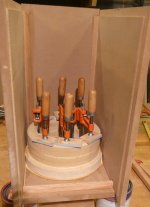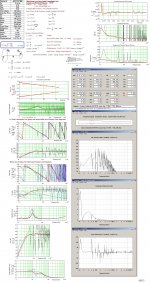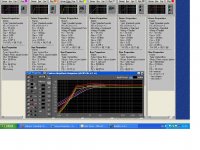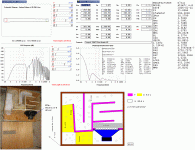i have a pair of 12" subs that i picked up a while ago and never got around to doing anything with them. now i've started sorted out other parts of my audio set up i need to get these doing something.
when using the parameters i have for them.
fs: 37.4hz
qms: 5.28
qes: 0.88
qts: 0.76
Vas: 69
its suggested that the driver will be best suited to a sealed box or open baffle type designs.
using the calculators at mh-audio.nl
they gave me basic sizes for enclosures. unsure if these are 'correct' it was just the numbers presented to me.
PORTED
Vdr - 4.25
460.25 litres
77.45cm X 125.31cm X 47.86cm
fb : 20.38
peak : 0.078
f-3 : 14.48
port area : 63.67cm2
port length : 3.43cm
SEALED
460ltr
82.69hz peak db
0.247db peak level @ fb
f-3 : 35.69
i had been interesting in playing with transmission lines/TQWT but my drivers are not well suited after some reading? after using the 'plot frequency response' function the sealed box is smooth, but the ported box gives a lot of output very low down which is something i'd consider desirable but my experience with ports have been boomy, harsh and port noise.
i would like low frequency response that is smooth. no nasty peaking at certain audible frequencies. if the port can be tuned to 20hz so its basically out of audible range then that would make a ported design more desirable.
during this reading i came across isobaric and their ability to reduce the total enclosure volumes? but i'm not sure i full understand all terminology given.
given the examples i quickly drew, for both ported and sealed boxes, what do the following setups do to the box sizes, output etc? if possible can it be explained in the very simplest of terms as there's a lot of stuff to try and assimilate at once with regards to these things.
thanks for your help.
when using the parameters i have for them.
fs: 37.4hz
qms: 5.28
qes: 0.88
qts: 0.76
Vas: 69
its suggested that the driver will be best suited to a sealed box or open baffle type designs.
using the calculators at mh-audio.nl
they gave me basic sizes for enclosures. unsure if these are 'correct' it was just the numbers presented to me.
PORTED
Vdr - 4.25
460.25 litres
77.45cm X 125.31cm X 47.86cm
fb : 20.38
peak : 0.078
f-3 : 14.48
port area : 63.67cm2
port length : 3.43cm
SEALED
460ltr
82.69hz peak db
0.247db peak level @ fb
f-3 : 35.69
i had been interesting in playing with transmission lines/TQWT but my drivers are not well suited after some reading? after using the 'plot frequency response' function the sealed box is smooth, but the ported box gives a lot of output very low down which is something i'd consider desirable but my experience with ports have been boomy, harsh and port noise.
i would like low frequency response that is smooth. no nasty peaking at certain audible frequencies. if the port can be tuned to 20hz so its basically out of audible range then that would make a ported design more desirable.
during this reading i came across isobaric and their ability to reduce the total enclosure volumes? but i'm not sure i full understand all terminology given.
given the examples i quickly drew, for both ported and sealed boxes, what do the following setups do to the box sizes, output etc? if possible can it be explained in the very simplest of terms as there's a lot of stuff to try and assimilate at once with regards to these things.
thanks for your help.
An externally hosted image should be here but it was not working when we last tested it.
I've tried building a few Iso boxes and found an inherent problem with the tunnel design (which are fun to make and look better). The front woofer is in a small - round space, not a good combination, you may end up with a ringing sound.
I found it starts up around 80hz; however, if you crossover say,,,60hz to 70hz I don't think you will hear it.
All said....I've been toying with an idea that may help the ringing problem, cut the rings in different sizes, make the tunnel an hour glass shape, vs. a straight shot; e.g. ><
Also may be a good place to spay car undercoater, but let that dry for about a week.
Here's a how-to pic to glue a tunnel up.
I found it starts up around 80hz; however, if you crossover say,,,60hz to 70hz I don't think you will hear it.
All said....I've been toying with an idea that may help the ringing problem, cut the rings in different sizes, make the tunnel an hour glass shape, vs. a straight shot; e.g. ><
Also may be a good place to spay car undercoater, but let that dry for about a week.
Here's a how-to pic to glue a tunnel up.
Attachments
Last edited:
gafhenderson:
...i had been interesting in playing with transmission lines/TQWT but my drivers are not well suited after some reading? after using the 'plot frequency response' function the sealed box is smooth, but the ported box gives a lot of output very low down which is something i'd consider desirable but my experience with ports have been boomy, harsh and port noise...i would like low frequency response that is smooth. no nasty peaking at certain audible frequencies. if the port can be tuned to 20hz so its basically out of audible range then that would make a ported design more desirable...during this reading i came across isobaric and their ability to reduce the total enclosure volumes? but i'm not sure i full understand all terminology given...
Hi,
Here is a suggestion of an OD-TL,IMO better than a ported design or a closed one:
b 🙂
PS: I didn't use your provided data but I suspected that in the given sparse data 😱 a crap Car driver was hidden that really IMO don't belong to this forum but should be posted to the 'Car Audio' forum in the first place.😀
Attachments
Last edited:
Clamshell mounting and a sealed box will give the smallest enclosure and easiest build.
Sealed isobaric 34.68l F3 47Hz
Vented isobaric 125.1l F3 19Hz
Below are the models for sealed, vented, iso-sealed, iso-vented, sealed double and vented double. You should be able to read the box volume and see the outputs relative to one another off 100w.
Sealed isobaric 34.68l F3 47Hz
Vented isobaric 125.1l F3 19Hz
Below are the models for sealed, vented, iso-sealed, iso-vented, sealed double and vented double. You should be able to read the box volume and see the outputs relative to one another off 100w.
Attachments
Clamshell mounting and a sealed box will give the smallest enclosure and easiest build.
Sealed isobaric 34.68l F3 47Hz
Vented isobaric 125.1l F3 19Hz
Below are the models for sealed, vented, iso-sealed, iso-vented, sealed double and vented double. You should be able to read the box volume and see the outputs relative to one another off 100w.
that was incredibly helpful, thank you for your time. givem the suggestion that they're probably fairly crappy driver units i'm drawn more towards the space saving that the isobaric seems to provide.
Hi,
Here is a suggestion of an OD-TL,IMO better than a ported design or a closed one:
b 🙂
PS: I didn't use your provided data but I suspected that in the given sparse data 😱 a crap Car driver was hidden that really IMO don't belong to this forum but should be posted to the 'Car Audio' forum in the first place.😀
OD-TL? i'm not very familiar with all terminology used on this forum, very very beginner.
i suspect you are correct that they are car audio drivers. they have that look. are dual voice coils more common in car subs?
tbf its a subwoofer. any correctly assembled is going to improve my current low end reproduction in movies no? my floor standing speakers seem to run out of useful noise below 50hz. so any extra grunt in the 20-80/100 range is welcome.
what would this set up be called and does it do anything/work? its not the passive radiator type, but both drivers active. is it still isobaric?
An externally hosted image should be here but it was not working when we last tested it.
Bjorno's box is a transmission line of some discription-not sure myself what the OD stands for!! I could do with a breakdown of all horns/TL/TQWT designs so it'd be easier to spot the difference! The SPL response of his design is very odd-not like the normal stuff I've seen him post-but I'd guess this is down to the drivers.
The picture you post above is a push pull design, but not isobaric. The benefit of the above design isn't smaller box volume, but reduced distortion from the two drivers opposing motion.
If the subs are the Audiobahn Bjorno's specs came form I'd love to know how he spotted it-he must be a speaker lexicon!
The picture you post above is a push pull design, but not isobaric. The benefit of the above design isn't smaller box volume, but reduced distortion from the two drivers opposing motion.
If the subs are the Audiobahn Bjorno's specs came form I'd love to know how he spotted it-he must be a speaker lexicon!
Bjorno's box is a transmission line of some discription-not sure myself what the OD stands for!! I could do with a breakdown of all horns/TL/TQWT designs so it'd be easier to spot the difference! The SPL response of his design is very odd-not like the normal stuff I've seen him post-but I'd guess this is down to the drivers.
The picture you post above is a push pull design, but not isobaric. The benefit of the above design isn't smaller box volume, but reduced distortion from the two drivers opposing motion.
If the subs are the Audiobahn Bjorno's specs came form I'd love to know how he spotted it-he must be a speaker lexicon!
reduced distortion sounds good. what would be a suitable search string for 'push pull design' to further read about them. the lack of familiarity with terminology and charts outside of basic frequency response are hindering the speed at which i am learning.
so far i am siding with the isobaric designs, slightly towards the sealed box but the frequency responses posted for the vented design didn't have any particularly nasty peaks so that has also captured my attention due to how low it could go. if its a crappy driver, then i won't waste a lot of space accommodating its use and i'm sure it will do fine as a beginner play thing till i better understand the concepts involved.
with regard to 'audiobahn' i just had a look on their website and the driver does look quite similar to some on there, so i am fairly impressed also at his investigational skills.
I built a clam shell style face-to-face isobaric with a passive radiator on the back.
The face-to-face is the best way to do it for several reasons. The tunnel thing has too much air space between the drivers to couple accurately, the air space is very small for one driver while the other one operates in a much larger space. Basically, one woofer will run hotter than the other one when driving them hard.
The face-to-face also is a push-pull loading scheme which cuts distortion to improve your sound quality. One of the drivers is sticking out in the open air for much better cooling and the other one is inside the box air space so it runs cool.
My isobaric-passive radiator sub was an entertaining and simple build, very simple to change the tuning on a passive to get it smooth in the actual room. Have fun with your spare parts laying around and hope your results surprise you.
The face-to-face is the best way to do it for several reasons. The tunnel thing has too much air space between the drivers to couple accurately, the air space is very small for one driver while the other one operates in a much larger space. Basically, one woofer will run hotter than the other one when driving them hard.
The face-to-face also is a push-pull loading scheme which cuts distortion to improve your sound quality. One of the drivers is sticking out in the open air for much better cooling and the other one is inside the box air space so it runs cool.
My isobaric-passive radiator sub was an entertaining and simple build, very simple to change the tuning on a passive to get it smooth in the actual room. Have fun with your spare parts laying around and hope your results surprise you.
Hi,
Here is a suggestion of an OD-TL,IMO better than a ported design or a closed one:
b 🙂
PS: I didn't use your provided data but I suspected that in the given sparse data 😱 a crap Car driver was hidden that really IMO don't belong to this forum but should be posted to the 'Car Audio' forum in the first place.😀
oh, OFFSET driver - transmission line? sorry for being blind. that post has so much information on it.
the part about Xmax of the driver, is that not going to kill the woofer given the specs you provided for the possible identity of the driver gives Xmax at 7mm?
if i'm honest most of your schematics completely elude my level of knowledge and intelligence. whatever you have created it seems quite loud. but fairly unusable after 60hz due to the irregularity of sound levels?
reduced distortion sounds good. what would be a suitable search string for 'push pull design' to further read about them. the lack of familiarity with terminology and charts outside of basic frequency response are hindering the speed at which i am learning.
TBH I don't know, it's just a normal sealed box with the drivers on opposing faces, same volume as you'd conventionally require
so far i am siding with the isobaric designs, slightly towards the sealed box but the frequency responses posted for the vented design didn't have any particularly nasty peaks so that has also captured my attention due to how low it could go. if its a crappy driver, then i won't waste a lot of space accommodating its use and i'm sure it will do fine as a beginner play thing till i better understand the concepts involved.
I re-modeled the ported ISO to 2cf, works out ok, but only a marginal improvement over the 1.25cf sealed iso in terms of extension. GD goes up a lot.
How much space can you give to this? I'll model some designs to fit that if you wish.
with regard to 'audiobahn' i just had a look on their website and the driver does look quite similar to some on there, so i am fairly impressed also at his investigational skills.
Yes, Bjorno is some kind of speaker ninja, I've been more than impressed with his skills on here, a real star member/contributor.
How much space can you give to this? I'll model some designs to fit that if you wish.
Yes, Bjorno is some kind of speaker ninja, I've been more than impressed with his skills on here, a real star member/contributor.
i don't want to waste your time. was just looking for a few pointers to get myself started towards drawing something up for critique then adjustment etc. all this is new to me.
as far as space, its really a case of space vs reward. a 400ltr box that only gives marginal advantages over 200 would obviously not be appealing. super small at the expense of being able to reach down low would not be appealing etc. loud and intrusive at the expense of quality would not be appealing.
so i guess medium sized, smooth low frequency?
i was drawn to transmission lines as they are fabled for low distortion and very smooth responses, however i know i've missed a lot of the complexities involved in creating a correctly function transmission line.
yes thanks bjorno for your input
I've modeled these drivers to death  I came up with a lumpy ported box🙁, a huge sealed box that would only work in a small car... 😕.. and a bandpass boom box. yuck.
I came up with a lumpy ported box🙁, a huge sealed box that would only work in a small car... 😕.. and a bandpass boom box. yuck.
What do you want to do with these?
I hate to say this...I'd sell them and start with a good driver for your application. whatever it is.
 I came up with a lumpy ported box🙁, a huge sealed box that would only work in a small car... 😕.. and a bandpass boom box. yuck.
I came up with a lumpy ported box🙁, a huge sealed box that would only work in a small car... 😕.. and a bandpass boom box. yuck. What do you want to do with these?
I hate to say this...I'd sell them and start with a good driver for your application. whatever it is.
I've modeled these drivers to deathI came up with a lumpy ported box🙁, a huge sealed box that would only work in a small car... 😕.. and a bandpass boom box. yuck.
What do you want to do with these?
I hate to say this...I'd sell them and start with a good driver for your application. whatever it is.
can't imagine i'll get much for them. they only cost me £10 for both so i thought they'd be a perfect candidate to play with and learn what happens with different enclosures and stuff. so then when i bought good stuff, i would be in a better position to best use it. like i said, its a no sub environment so even at its worst its bound to help add some low end kick to movies.
if they are very bad, then its probably the ideal thing to try and learn with because surely knowing how to make bad sound good will surely mean you can make good sound impeccable?
could you post the outputs of what you modelled so i can see what it looks like compared to what others posted as some of the graphs didn't look so bad in ported and sealed boxes. imagine it was a lot better then my last subwoofer experience. a little 8 inch ported eltax thing that sounded like an asthmatic hitting a drum wheeze thud wheeze thud thud pop wheeze.
... imagine it was a lot better then my last subwoofer experience. a little 8 inch ported eltax thing that sounded like an asthmatic hitting a drum wheeze thud wheeze thud thud pop wheeze...
Hi, Know what you are talking about but a true DIY'r can turn a inexpensive woofer from a crap commercial wheeze design into a killer..if compared to the original.
Here is a suggestion for an Eltax Atomic A-8 driver moved to a simple folded T-TQWT I made a couple of years ago. Still in use with a PC based system setup for listening to quality recorded music in a dorm room:
b🙂
Attachments
It really doesn't take much time-I already have the parameters in BBpro so rasing or lowering box volume takes less time than typing the reply!
Fairly small sealed with Linkwitz Transform, anyone?
Alternatively, if you still have your 8" Eltax woofer, build the thing that Bjorno built. I suspect it'll sound better than most things with the cheapy 12"s.
Alternatively, if you still have your 8" Eltax woofer, build the thing that Bjorno built. I suspect it'll sound better than most things with the cheapy 12"s.
Done that in my car-but then the car works great as the EQ. Will depend what else he has in terms of equipment I'd guess.
Hi, Know what you are talking about but a true DIY'r can turn a inexpensive woofer from a crap commercial wheeze design into a killer..if compared to the original.
Here is a suggestion for an Eltax Atomic A-8 driver moved to a simple folded T-TQWT I made a couple of years ago. Still in use with a PC based system setup for listening to quality recorded music in a dorm room:
b🙂
i don't have the old subwoofer any more but the response you posted for what you made the subwoofer do, looks perfect to what i had in my mind! nice and smooth up to 100hz, the original ported eltax box certainly didn't do that!
can that same level of performance be achieved from the 2 12inch drivers i have currently in some guise?
btw thank you very much, that last set-up has actually left me amazed and full of hope that i can turn £10 2nd hand car woofers into something useful!
Last edited:
Fairly small sealed with Linkwitz Transform, anyone?
Alternatively, if you still have your 8" Eltax woofer, build the thing that Bjorno built. I suspect it'll sound better than most things with the cheapy 12"s.
if this requires the construction of custom electronics then i'm perhaps not quite to that stage of competence yet. i've started reading about the electrical side but its incredibly complex and will take years to get a basic understanding.
- Status
- Not open for further replies.
- Home
- Loudspeakers
- Subwoofers
- 'isobaric' schooling help please.



